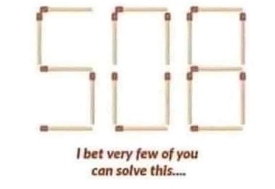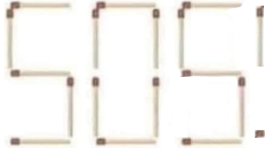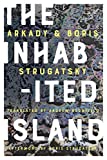Archive for the ‘Puzzles’ Category.
Alexey’s Puzzle
My son, Alexey Radul, designed a puzzle for my students.
Puzzle. Simplify the expression: ln ln a · ln ln b · ⋯ · ln ln z.
Share:
MIT Mystery Hunt 2023
Every year, I used to blog about math-related puzzles from that year’s MIT mystery hunt. However, I want to skip this year. I participated in the hunt, and a few of the puzzles I saw were not good enough. Moreover, the puzzles had boring steps or were inelegant. I am not motivated to sift through every math puzzle in the hunt and check its quality.
This year, instead of cataloging all the math puzzles, I will present a short list of puzzles from the hunt that were recommended to me by others. Most of these puzzles are unrelated to math, but I checked them out, and they seem cool.
After the hunt, I asked two people about their favorite puzzles. Both of them mentioned Showcase. Looking at it, I know why. I’ll give you a hint: this puzzle will appeal to people doing competitive programming.
Here are some other recommendations.
- Scicabulary, this is a word puzzle.
- Natural Transformation, you are presented with some very structured images.
- Collage, this is a funny farm.
- Cute Cats, you are presented with many images, some of them with cats.
- Hall of Archaeology, this is a Nikoli-type puzzle.
- Museum Rules, this puzzle looks like a children’s picture book.
- This Puzzle is Just Another Regular Cryptic, this is a cool cryptic puzzle.
- Parsley Garden, you are presented with a grid of words.
- Dispel the Bees, you are presented with crossword clues.
Share:
Move Two Matches to Get the Largest Number

Puzzle. If you can move exactly two matches, what is the largest possible number you can get?
Many people assume that given that 508 has three digits, the answer also has three digits. They get the number 999 and stop there.
Some students realized they can make an extra 1 out of two matches and gave answers with four digits: 1503, 5051, and 5103.
Another great idea is to take out the two horizontal matches from 0, turning the 0 into 11. For example, one might use the two matches to turn 5 into 8 and get 8118. However, we can combine this idea with the previous one and use the two matches to make a new digit 1 to get 51181.
When I first saw this puzzle several years ago, 51181 was the official answer. But my students went further, much, much further.
Another elegant idea is to rotate the picture and get 81151.
Some students decided that having all the digits be the same height is not very important. One vertical match reads as 1, even if it is half the height. The largest number they got this way was 511811. Combining this idea with flipping the number allows us to get 811511.
However, small-font digits are often used in powers. This train of thought led to a brilliant answer, 511811. This number is way larger than everything we saw before: it has 41 digits. If we combine this idea with rotating the number, we can get 811511, a 43-digit number.
I recently decided to check the Internet again and discovered a chain of videos showing solutions to this puzzle by the same author. He started with a simple solution, 51181, then people left comments in the video with better solutions, so he remade the video. This happened several times. I probably should send him a link to this essay for yet another video.
Here is an interesting solution by one of my students that I haven’t seen anywhere else. The idea is to use scientific notation. The student took two matches from the right side of 0. He used one of them to convert the first digit from 5 to 9 and the second digit from 0 into the letter E. He got 9E8 = 900000000. If we combine this idea with using a small 1, we can get 5E81, an 82-digit number.
Another brilliant idea is using two matches to create a caret symbol representing an exponent. This way, we can get 5^118, which is an 83-digit number. If we combine this idea with the rotation idea, we can get 8^115, a 104-digit number.
If we ignore the relative sizes of the digits, we can have the small digits as the base of the exponent and the larger digits as the power. One of the students suggested 115118, a 5330-digit number. And if we rotate the number, the answer we can get is 118115: the number with 8451 digits. This is a humongous number compared to the mere 3-digit one we started with, to the pathetic 5-digit original solution, and to the pitiful 104-digit previous record. But my students didn’t stop there.
One student suggested snapping two matches and creating a double factorial 505!!, with 575 digits. Combining this with other ideas, we can get 8115!!, a 14102-digit number.
One of my students decided to use two matches from the last digit 8 to create a factorial sign. She glued one of the matches perpendicular to the plane to get 505! in the projection. She even made a picture that you can see below. This number has 1148 digits, and combining this with previous ideas, we can get 5118!, which has 16763 digits. Or even 8115!, which has 28202 digits.

For this puzzle, a factorial works better than a double factorial. Here is my own suggestion: use one of the matches to create a small digit one, and split the other match into a factorial. This way, we can get 81151!, a number with a whooping 363154 digits.
This is an excellent example of a thinking-outside-the-box puzzle. I love this puzzle because it has not one, but many boxes one can think outside off.
Share:
Don’t Read This Sentence
Sometimes I mess with my students. Recently, I gave them the following problem for homework.
Puzzle. Don’t read this sentence.
This problem is a paradox: students can’t know not to read it unless they read it! I expected my students to explain the paradox, and a couple of them did. But, most of them provided me with an infinite stream of entertainment. Here are some of their answers divided into categories, starting with the apologizing ones, and there were a lot of those:
- Oopsie.
- Too late?
- My apologies.
I wasn’t surprised by the apologies, as this problem is intended to be intimidating. However, other students tried to wiggle out of it:
- Next time, I will ask my parents to read my homework to me.
- A person named Don’t read, in the past tense, “this sentence”. I read this sentence, too!
- I happen to have conveniently forgotten English, and it cannot be proven otherwise.
Yet other students decided to rebel:
- Why not?
- I didn’t.
- You just lost your game.
- I will never read anything again, as it says, “Don’t read.”
Karma is a boomerang, and this problem got me into a pickle. One of the most brilliant and funny solutions possible was to leave the answer box blank, implying that the sentence wasn’t read. However, how would I grade this? What if they just skipped the problem? I decided to err on the students’ side and gave full credit for an empty answer box.
A couple of students made a point of pretending they didn’t read the sentence:
- Which sentence?
- I see an answer box, but there’s no problem.
But I saved the best for last. My favorite answer was the following:
- Don’t read this answer.
A Chess Puzzle
Share:Puzzle. Alice and Bob play the following game on a regular chessboard, where all the pieces move according to the standard rules of chess. Alice has a king, and Bob has a knight. They would place their pieces on the chessboard without attacking each other. Alice starts, and they alternate moves. Alice loses if the knight checks or all available moves place her under the knight’s attack. For which initial positions of the pieces is Bob guaranteed a win?
A Silent Parrot
Puzzle. “I guarantee,” said the pet-shop clerk, “that this parrot will repeat every word it hears.” A customer bought the parrot but found it wouldn’t speak a single word. Nevertheless, the clerk told the truth. Explain.
The official answer:
- The parrot is deaf.
Indeed, in this case, it is not a lie that the parrot will repeat every word it hears. My students had some other ideas. The following answer differs from the official one by one letter, but the spirit of the solution is the same.
- The parrot is dead.
Another idea my students had was to introduce a time component.
- The parrot wasn’t guaranteed to say the lines immediately; it would wait 30 years before repeating any words.
- The parrot only repeated the words in the customer’s absence.
And a couple of outside-of-the-box answers.
- The parrot was a toy and did not have a battery in it.
- The customer mistook the pet-shop owner to say the statement about the parrot when in fact, the parrot was saying it.
Share:
A Puzzle Courtesy of Dick Hess
Puzzle. Alice and Bob divide a pie. Alice cuts the pie into two pieces. Then Bob cuts one of those pieces into two more pieces. Then Alice cuts one of the three pieces into two pieces. In the end, Alice gets the smallest and the largest piece, while Bob gets the two middle pieces. Given that both want to get the biggest share of the pie, what is Alice’s strategy? How much can she get?
Share:
Towers
I got immediately attracted to the puzzle Oleg Polubasov recently posted on Facebook.
Puzzle. A rectangular clearing in a forest is an N-by-M grid, and some of the cells contain a tower. There are no towers in the cells that neighbor the forest. A tower protects its own cell completely and parts of the eight neighboring cells at a depth of half of a cell. Here by neighbors, we mean the cells horizontally, vertically, and diagonally adjacent to the given cell. In particular, if each cell is one square unit, a tower protects four square units. The protected area forms a square with borders that lie in between the grid lines. A tsar knows the towers’ locations and wants to calculate the protected area. Prove that the following formula gives the answer: the number of 2-by-2 subgrids that contain at least 1 tower.

I like this puzzle because it has an elegant solution. But there is more. The puzzle reminds me of one of my favorite novels by Arkady and Boris Strugatsky: The Inhabited Island, also known as Prisoners of Power. This is a science fiction novel where Max Kammerer, a space explorer, ends up on a planet with desolate people who, twice daily, experience sudden bouts of enthusiasm and allegiance to the government. Later, it becomes clear that the love for the rulers comes from towers that broadcast mind-control signals suppressing critical thinking and making people prone to believe propaganda.
The novel was written in 1969 but accurately describes the modern Russian propaganda machine. It appears that there is no need for a secret signal. Just synchronized propaganda on government-controlled TV turns off people’s brains.
Share: